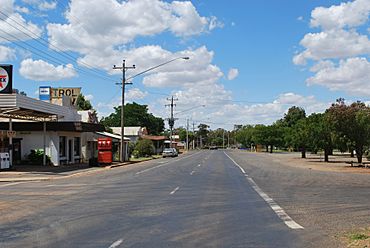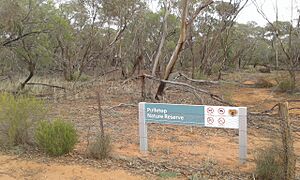Rankins Springs facts for kids
Quick facts for kids Rankins SpringsNew South Wales |
|
|---|---|

Mid-Western Highway passing through Rankins Springs
|
|
| Population | 208 (2021 census) |
| Postcode(s) | 2669 |
| Elevation | 221 m (725 ft) |
| Location |
|
| LGA(s) | Carrathool Shire |
| County | Cooper |
| State electorate(s) | Murray |
| Federal Division(s) | Riverina |
Rankins Springs is a small village in the Riverina area of New South Wales, Australia. It is part of Carrathool Shire and sits right on the Mid-Western Highway. In 2021, about 208 people lived here. The village stretches along the highway and the railway line. Farmers in the area mostly grow crops like wheat and oats, and raise beef cattle.
Contents
History of Rankins Springs
The story of Rankins Springs involves two different settlements. They were about 10 kilometres (6 miles) apart. The first settlement was near a water source. It had a hotel, a store, and a post office. The newer village of Rankins Springs grew up around the end of a railway line. This railway was finished in 1923.
The First Settlement Site
The original Rankins Springs was 10 km (6 miles) north-east of where it is now. It was located near a narrow gap in the Conapaira Range. The name probably comes from Arthur Ranken. He was a pastoralist, meaning he owned large areas of land for grazing animals. He had land south of the Lachlan River in the 1840s.
The spot was likely named "Rankin's Springs" because it had reliable water. This water was important for animals traveling on a stock route. A stock route is a path used to move livestock across dry land. This route connected the Lachlan and Murrumbidgee rivers. The springs were at the foot of the Conapaira Range. This was a good place for animals and wagons to cross the rocky hills.
People started living permanently at Rankin's Springs in 1869. At this time, the government wanted more people to settle inland. They also started breaking up large grazing lands. The location of Rankin's Springs, with its roads and water, was perfect for a small town. It could offer services to travelers and local residents.
In the early 1870s, a hotel was built at Rankin's Springs. It was called the Rankins Springs Hotel. John Dwyer was the first person to get a license for it in 1872. Over the years, different people ran the hotel. James Graham held the license for many years, from 1874 to 1888.
A post office opened at Rankins Springs on September 1, 1875. James Graham, the hotel owner, was also the postmaster. Mail services connected Rankins Springs to other towns like Narrandera and Ungarie. The post office was in a separate building that also served as a store.
In 1892, a fire destroyed the Rankins Springs Hotel. The owner planned to build new, stronger buildings. These new buildings would be made of stone. They would include a hotel, kitchen, store, and post office. The new hotel was expected to be ready in early 1893.
John Hannan took over the new hotel in 1893. He ran it until 1923. Around 1918-1919, John Baxter bought the hotel and the land around it. In 1926, the hotel was described as being made of stone and cement. It had five bedrooms for guests.
The Village at the Railway
In January 1923, a railway line opened. It connected the Rankins Springs area to Barmedman. The new railway line did not go through the old hotel site. Instead, the Rankins Springs station was built 10 km (6 miles) south-west of the hotel. This new line helped transport farm products and also carried passengers.
By July 1926, the new village of Rankins Springs was growing fast. It had about 120 people living there. New buildings were being built, including a public hall, a garage, a bakery, and a store.
Meetings were held to decide what to do with the old hotel's license. It was decided to move the license to a new hotel. This new hotel would be built in the growing village of Rankins Springs. The new hotel was a two-story brick building. It was also called the Rankins Springs Hotel. It was finished by September 1928. A police station also opened in the village in October 1928.
The new Rankins Springs Hotel was destroyed by fire soon after it was built. A replacement, another two-story brick building, was built by early 1930. It cost a lot of money to build.
On May 31, 1939, another fire completely destroyed the Rankins Springs Hotel. The fire started in a billiard room. It quickly spread because of a strong wind. Volunteer firefighters had trouble because there was not enough water or equipment. The owner, John Baxter, rebuilt the hotel. A new hotel opened in early 1941. It was a two-story building with 17 bedrooms and modern features. It was named the Conapaira Hotel.
In 1951, a film called Rankins Springs is West was made. It was by the Shell Company of Australia. The film showed how modern kerosene appliances could help people in country towns. It showed how even remote homes could have comforts like those in the city.
In 1974, the NSW Government stopped many country train services. This included the passenger train service to Rankins Springs.
In December 1982, during a big drought, an article described Rankins Springs as "a township that is hanging on to life." It was seen as a service town for local farmers. Its main features were the petrol station, post office, hotel, and caravan park. With better roads, people could easily go to bigger towns like Griffith for shopping. This meant the town kept only its most important services. The postmistress, Mrs. Dulcie Wood, noted that young people often left after school because there were few opportunities.
In 2004, the railway line for carrying grain from the village closed. This was because the branch line from Barmedman to Rankins Springs was shut down.
In 2008, a water treatment plant was built for the village. This gave the community clean drinking water. Before this, residents used rainwater or untreated bore water. Sometimes, clean water had to be brought in.
Natural Environment Around Rankins Springs
The area around Rankins Springs is part of the Lachlan Plains. This region is within the large Cobar Peneplain Bioregion. This bioregion covers about 9.2 percent of New South Wales.
Birdlife in the Area
Rankins Springs and its surroundings have many native animals, especially birds. You can see many different kinds of birds here. Some parrot species found include the glossy black cockatoo, superb parrot, and Major Mitchell's cockatoo.
Some rare or threatened native bird species live in the district. These include the malleefowl, Gilbert's whistler, chestnut quail-thrush, shy heathwren, and the painted honeyeater. There are seven special places for birdwatching in the Rankins Springs area. Some even have hides, which are shelters where you can watch birds without disturbing them.
Jimberoo National Park
Jimberoo National Park is located eight kilometres north of Rankins Springs. It used to be a state forest. It became a national park on January 1, 2011. The park is 1161 hectares in size. It was created to protect areas of cypress pine woodlands. These woodlands are important in a region that has been largely cleared for farming.
Jimberoo National Park is made up of rocky ridges and foothills. These extend through the Cocoparra, Conapaira, and Naradhan Ranges. The park has woodlands with trees like bimble box, white cypress pine, Dwyer's red gum, and black cypress pine.
Pulletop Nature Reserve
Pulletop Nature Reserve is 22 kilometres south-west of Rankins Springs. It has 145 hectares of mallee woodland. Mallee is a type of eucalyptus tree that grows with many stems from the ground. This reserve is surrounded by farmland. The land in the reserve is mostly flat or gently rolling. It has sandy soils. The reserve was set aside in 1963.
Pulletop was a key place for scientific research on the malleefowl. This research began in 1951. Harry Frith, a scientist, studied the malleefowl's behavior and how it lived. He wrote many scientific papers and a popular book called The Mallee-Fowl: The Bird That Builds an Incubator (1962). This book also gave advice on how to protect malleefowl.
Pulletop Nature Reserve is like a safe haven for native species. It is isolated and surrounded by cleared farmland. A total of 123 types of mallee and woodland birds have been seen in the reserve. However, some species have declined. This is because the reserve is small and isolated. Also, predators like cats and foxes can harm the birds. The malleefowl, which is a special bird for the reserve, was last seen there in the 1980s. It is now thought to be gone from this area.
Rankins Springs Grevillea
There is a special type of rosemary grevillea plant. It is commonly called the Rankins Springs grevillea (Grevillea rosmarinifolia subsp. glabella). This plant grows in sandy soils. It is found only in the Rankins Springs area and around Griffith.
Gallery







